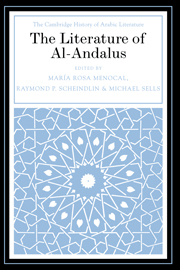Book contents
24 - The Arabized Jews
from PART V - MARRIAGES AND EXILES
Published online by Cambridge University Press: 28 May 2012
Summary
In the Muslim East, a literary intellectual of Arabic and Persian traditions might well earn the honorific dhū l-lisānayn – one who commanded the two principal languages in which Islamic culture was then conducted, preserved, and transmitted. Members of the Muslim oikoumēnē of a different order and a singular socioreligious condition, the Jews of al-Andalus also esteemed cultural literacy in two languages, one of which was Arabic. Moses Ibn Ezra’s (d. c. 1138) epistolary lyric to Abū Ibrāhīm (Isaac) Ibn Barun (eleventh century), the author of a comparative grammar and lexicon, Kitāb al-muwāzana bayn al-lugha al-ʿibrāniyya wa l-ʿarabiyya (Book of Comparison between the Hebrew and Arabic Languages), and Judah Halevi’s (d. 1141) rhymed-prose salute to Ibn Ezra, the venerable dean of Andalusi-Jewish letters, among many texts expressing similar sentiments, unambiguously set forth the Andalusi Jews’ cultural ideal valorizing Arabic as well as Hebrew learning. Other texts authored by these figures bespeak a more complex and ambivalent sense of the Jews’ multiple cultural loyalties.
The literary culture of the Arabized Jews of al-Andalus represents, among other things, a particular instance of the general development of the Jews under Islam during the Middle Ages. Afforded economic opportunity, religious freedom, and social integration in the defined role of “protected people,” Jews were also caught up in the intellectual stimulation and challenges of Islamic civilization. The principal means by which the Jews of Islam west of the Iranian plateau gained access to the economic and social domain of Islam as well as its cultural realm was their apparently swift adoption of Arabic as the language of everyday life, an accommodation that also saw them employ Arabic as their primary although not sole literary language.
- Type
- Chapter
- Information
- The Literature of Al-Andalus , pp. 435 - 454Publisher: Cambridge University PressPrint publication year: 2000
References
- 6
- Cited by

